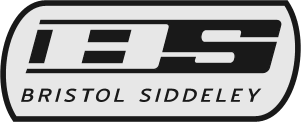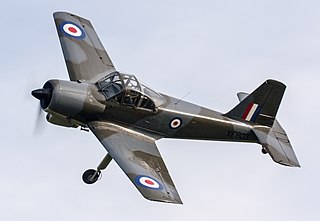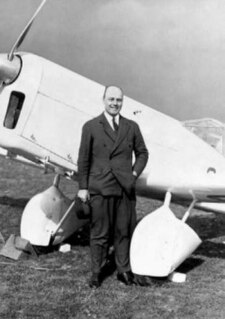Related Research Articles
Saunders-Roe Limited, also known as Saro, was a British aero- and marine-engineering company based at Columbine Works, East Cowes, Isle of Wight.
Armstrong Siddeley was a British engineering group that operated during the first half of the 20th century. It was formed in 1919 and is best known for the production of luxury vehicles and aircraft engines.

The BAC Jet Provost is a British jet trainer aircraft that was in use with the Royal Air Force (RAF) from 1955 to 1993. It was originally developed by Hunting Percival from the earlier piston engine-powered Percival Provost basic trainer, and later produced by the British Aircraft Corporation (BAC). In addition to the multiple RAF orders, the Jet Provost, sometimes with light armament, was exported to many air forces worldwide. The design was also further developed into a more heavily armed ground attack variant under the name BAC Strikemaster.

Bristol Siddeley Engines Ltd (BSEL) was a British aero engine manufacturer. The company was formed in 1959 by a merger of Bristol Aero-Engines Limited and Armstrong Siddeley Motors Limited. In 1961 the company was expanded by the purchase of the de Havilland Engine Company and the engine division of Blackburn Aircraft. Bristol Siddeley was purchased by Rolls-Royce Limited in 1966.

The Gloster Aircraft Company was a British aircraft manufacturer from 1917 to 1963.
Hunting Aircraft was a British aircraft manufacturer, that produced light training aircraft and the initial design that would evolve into the BAC 1-11 jet airliner. Founded as Percival Aircraft Co. In 1933, the company later moved to Luton, UK. It was eventually taken over by the British Aircraft Corporation (BAC) in 1960.

The Percival Gull was a British single-engined monoplane, first flown in 1932. It was successful as a fast company transport, racing aircraft and long-range record breaker. It was developed into the Vega Gull and the Proctor.

Elliott Brothers (London) Ltd was an early computer company of the 1950s–60s in the United Kingdom. It traced its descent from a firm of instrument makers founded by William Elliott in London around 1804. The research laboratories were originally set up in 1946 at Borehamwood and the first Elliott 152 computer appeared in 1950.

The Percival P.56 Provost is a basic trainer aircraft that was designed and manufactured by British aviation company Percival.

The Percival Vega Gull was a 1930s British, four-seater touring aircraft built by Percival Aircraft Limited. It was a single-engine, low-wing (Folding), wood-and-fabric monoplane with a fixed tailwheel undercarriage.

The Spartan Cruiser was a 1930s British three-engined transport monoplane for 6 to 10 passengers built by Spartan Aircraft Limited at East Cowes, Isle of Wight. It was a development of the Saro-Percival Mailplane for passenger use.

Spartan Aircraft Limited was a British aircraft manufacturer from 1930 to 1935. It was formed by reinvestment in Simmonds Aircraft which had suffered financially.

The Percival Prince is a British light transport of the early postwar period. It was a twin-engine, high-wing, cantilever monoplane of all-metal stressed-skin construction; the undercarriage was of retractable, tricycle type.

The Percival Mew Gull was a British racing aircraft of the 1930s. It was a small, single-engine, single-seat, low-wing monoplane of wooden construction, normally powered by a six-cylinder de Havilland Gipsy Six piston engine. During its racing career it set many records and was considered a significant, efficient design, one that eventually reached a top speed of 265 mph (425 km/h) on a modest 205 hp (153 kW) in its final 1939 form. A modern-day observer has characterised the Mew Gull as "the Holy Grail of British air racing". During the second half of the 1930s, Mew Gulls were dominant in air-racing in the UK and consistently recorded the fastest times until the outbreak of war stopped all civilian flying in late 1939.

The Handley Page (Reading) H.P.R.1 Marathon was a British four-engined civil transport aircraft, capable of seating up to 20 passengers. It was designed by Miles Aircraft Limited and largely manufactured by Handley Page (Reading) Limited at Woodley Aerodrome, Reading, England.

Edgar Wikner Percival was a noted Australian aircraft designer and pilot whose aircraft were distinguished by speed and grace. Percival went on to set up the Percival Aircraft Company, a British aircraft company in his own name.

The Edgar Percival E.P.9 was a 1950s British light utility aircraft designed by Edgar Percival and initially built by his company, Edgar Percival Aircraft Limited and later as the Lancashire Aircraft EP-9 Prospector by the Lancashire Aircraft Company.

The Hendy 302 was a British two-seat cabin monoplane designed by Basil B. Henderson and built by George Parnall & Company Limited at Yate in 1929. Only one aircraft was built registered G-AAVT.
Moss Brothers Aircraft Ltd , known as Mosscraft, was an English aircraft manufacturer and repairer which was active between 1936 and the mid-1950s.

Lancashire Aircraft Corporation was a major British charter airline after World War II. Its founding father was Eric Rylands. It played an important role in the Berlin Airlift. It also flew scheduled routes and was important in the development of Coach-air services, leading to the founding of Skyways Coach Air and the start of the Inclusive Tour (IT) industry. Its major subsidiary, Samlesbury Engineering, supported its operations and converted many military aircraft for commercial use, also founding Lancashire Aircraft Company.
References
- The Illustrated Encyclopedia of Aircraft (Part Work 1982–1985). Orbis Publishing.
- Jackson, A.J. (1974). British Civil Aircraft since 1919 Volume 2. London: Putnam. ISBN 0-370-10006-9.